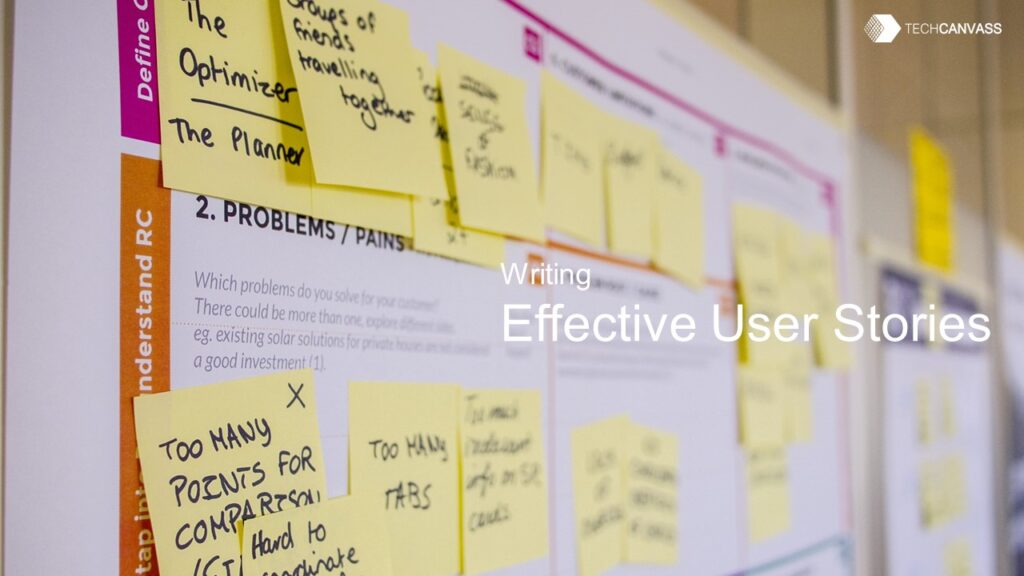Last Updated on March 14, 2024 by Techcanvass Academy
A user story is a powerful technique to capture early-stage requirements. User stories make it simpler for everyone to have an early shared understanding since they capture the WHO, WHAT, and WHY of a demand. Let’s learn Why Writing Effective User Story is important?
However, an effective user story needs a good understanding of the character and storyline. So, How can we be good at writing effective user stories? Before getting into that, let’s first understand the basics of user stories.
What are User Stories?
User Story is a popular format for representing a feature or user requirements of a software system from an external user perspective. The format comprises three key elements as shown below:
As a <User role>
I want <to do something>
So that I can <achieve some goal>
The user stories, not only, represent the system feature/requirements, but it also explains – why it is being done?
Tips to write User Stories
Writing user stories is one of the most popular agile techniques to ensure better product functionality. Anyone can work with the in-depth user story but telling the best one is hard. Below are the tips to ensure that next time you deliver the best user stories without any hard hustle.
Create stories in collaboration
User stories are designed to be a simple method that lets you work quickly. They are a tool for collaboration rather than a specification. A development team should never receive a story. Instead, they ought to be a part of a dialogue in which the team and the product owner discuss the tales. You can use this to cut costs, speed up delivery, and acquire the absolute least amount of data. This strategy can be expanded upon by incorporating collaborative story writing into the process of refining your product backlog. Better user stories are produced as a result of utilizing the team’s creativity and knowledge.
User personas come first
Working with personas is a great way to deal with your users and customers. Now, you must be thinking what does a persona means? Persona is virtual characters created to understand the functionality of a target group or users. These personas are facts and research-based after analyzing lots of data. The persona goals help to identify the right story and work upon it accordingly.
Keep it simple
Write your tales in a simple, straightforward manner. Keep them short and basic. Use an active voice and stay away from vague and misleading terminology. Leave aside the rest and concentrate on what matters. The example below incorporates the personalized user or customer into the narrative and makes clear how they will benefit. It is based on Rachel Davies’ well-known template, but I changed the user role to the name of the relevant persona to tie the story to that persona.
Initiate with Epics
Epics are big, long, and outreach stories that are broken down into smaller stories for a better understanding of the writer. It gives the early user experience and product prototype to the owners. You can sketch out the functionality of the product by starting with epics before committing to the details. This is very useful when introducing new features and products: It helps you to broadly define the scope and buys you some time to research the most effective ways to meet customer needs.
Refine the user stories until ready
If your epics are not clear, realistic, and testable yet, break them up into smaller, more specific stories. The story should be manageable enough to fit into a sprint, have a common understanding among all development team members, and have a reliable method for determining when it is finished.
Include acceptance criteria
Always remember to include acceptance criteria when segmenting epics into shorter stories. Acceptance criteria are a useful addition to the narrative since they let you explain the requirements that must be met before the story can be considered complete. The requirements ensure that the story can be demonstrated or distributed to users and other stakeholders, they make it testable.
Keep your Stories Accessible and Visible
Informational stories aim to convey knowledge. Don’t hide them, but make them noticeable by hanging them up on the wall. This encourages collaboration, increases transparency and makes it evident when you add too many stories too rapidly to the wall space.
How to add details to user stories
There are two ways to add details to user stories:
- By the division of a user narrative into numerous, smaller user stories.
- Conditions of satisfaction are added.
By including the following conditions of satisfaction, more detail may be added to that user story example:
- Ensure that it functions during the following significant shopping holidays: Christmas, Easter, President’s Day, Mother’s Day, Father’s Day, Labor Day, and New Year’s Day.
- Holidays that span two calendar years are encouraged (none span three).
- From one holiday to the next, holiday seasons may be determined (such as Thanksgiving to Christmas).
- Seasons for holidays can be set to begin a certain number of days before the holiday.
Who writes User Stories?
User tales are open to all writers. Although it is the product owner’s duty to ensure that an agile user story product backlog exists, this does not imply that the product owner is also responsible for writing the user stories. You should anticipate that each team member will write a user narrative example during a successful agile project. Also, keep in mind that who contributes to a user story’s discussion is significantly more crucial than who actually writes it.
All team members at Stormotion who are involved in the project’s business side (sales managers, marketers, product owners, etc.) write user stories since doing so allows us to consider the future app from the viewpoint of each prospective user type. In this situation, it is the Product Owner’s duty to ensure that they meet the INVEST criteria.
When are User Stories written?
Throughout the agile project, user stories are written. Near the beginning of an agile project, a story-writing workshop is typically held. With the aim of developing a product backlog that completely outlines the functionality to be added over the length of the project or a three to six-month release cycle within it, the entire team participates.
Undoubtedly, some of these agile user stories will be epics. Later, epics will be divided into smaller storylines that can be completed in a single cycle. In addition, anyone at any moment can write new stories and add them to the product backlog.
Benefits of Creating User Stories
The benefits of creating user stories are endless and if you are working as an agile, you must know how to write a good user story. User story not only gives you a breakthrough into the product details but also helps understand the user persona in detail. Below are a few of the benefits of creating a user story for your product.
- Maintain your attention on the company value. Making your app functional for end-users as well as technically sound can help it succeed.
- Encourage imagination. Your team is free to drive innovative ideas to identify the best way to implement a Story because it just offers a minimal quantity of information.
- It gets easier to handle your project. We are aware that working with tiny, manageable Agile User Stories is much simpler than working on large, difficult jobs.
- They motivate the group! Every developer enjoys the sweet sensation of a tiny victory because it inspires them to work harder.
- They improve communication and transparency as user stories improve communication between team members, the product owner, and stakeholders. Everyone can see the index cards, which promote better collaboration and quicker decision-making.
- They reduce risks as effective User Stories remove various potential hazards, including lack of communication risk, technical risk, financial risk, business risk, etc. by fostering transparency, enhancing collaboration, developing shared knowledge, and orienting the teams to focus on customer demands.
User Story Example
Now, we will understand an effective user story base on an example. A customer is looking to get a travel portal for flight ticket booking.
As a <User>
I want <to search for flight tickets as per my schedule>
So that I can <so that I can attend a business conference>
The good thing about user stories is that every stakeholder (customer as well as developers) gets a complete idea about the requirements.
What is the Invest Principle for writing User Stories?
What are the characteristics of a good user story? Well-written user stories are critical to the success of a project. INVEST represents the characteristics of a good user story as explained below:
- Independent – User Stories should be as independent as possible.
- Negotiable – User Stories are not a contract. They are not detailed specifications. They are reminders of features for the team to discuss and collaborate to clarify the details near the time of development.
- Valuable – User Stories should be valuable to the user (or owner) of the solution. They should be written in user language. They should be features, not tasks.
- Estimable – User Stories need to be possible to estimate. They need to provide enough information to estimate, without being too detailed.
- Small – User Stories should be small. Not too small. But not too big.
- Testable – User Stories need to be worded in a way that is testable, i.e. not too subjective and to provide clear details of how the User Story will be tested.
In addition, to INVEST principle, some important points should also be considered while writing user stories:
- At the time of writing the user story, the requirements would not be very clear. It is advisable to capture all the assumptions and constraints related to requirements/user stories. These assumptions provide the basis for managing risks.
- Ensure that user stories are written clearly and have no ambiguity. A very famous example is the usage of the word bi-weekly. Many people treat it as once in 15 days, whereas another group of people may consider this as twice in a week.
- Use a mutually agreed user story format as there is no standard format of a user story and that can lead to confusion.
- Clearly mention the Acceptance Criteria. Do acceptance criteria help in the definition of DONE? The done definition helps in identifying when a user story is completed
- It’s always advised to keep refining the product backlog. This will ensure that new user stories are getting added to the list and also the stories which were on low priority might get enough attention.
Conclusion
We hope this guide on writing effective user stories was insightful and you were able to draft your user stories. Moreover, If you have any tips for creating user stories that work, we would be pleased to hear them in the comment section.



